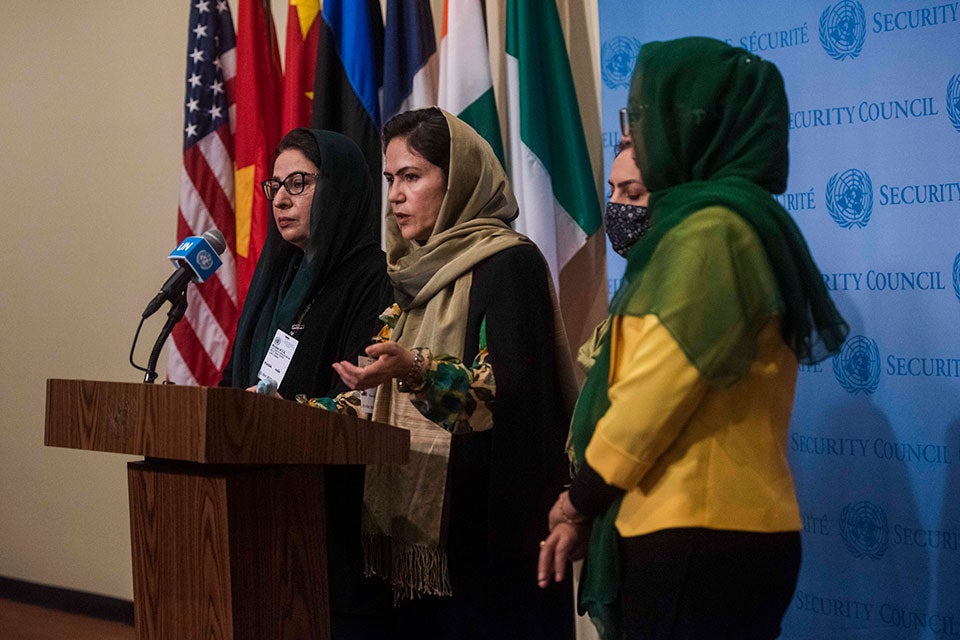
Afghan women leaders and human rights defenders speak to press outside of the UN Security Council chambers on 21 October 2021. Pictured from left to right: Asila Wardak, Fawzia Koofi (speaking), Anisa Shaheed and Naheed Farid. Photo: UN Women/ Amanda Voisard
by Hammad Baloch 25 September 2023
In collaboration with Mona Chalabi, UN Women has embarked on a crucial mission to spotlight the grave constraints imposed on women and girls in Afghanistan, severely curtailing their access to public spaces and participation in public life. The concept of “freedom of movement,” deeply rooted in international treaties, serves as the backdrop for this collective effort. Their collaborative work aims to emphasize the alarming velocity at which advancements in gender equality can disintegrate, regressing rapidly within a matter of months, all while the international community observes with growing concern.
Amidst a landscape of global social movements, the Afghan women’s rights movement emerges as a beacon of unwavering resilience and determination. This arduous struggle for freedom and equality traverses generations, with one recurring, fervent battle at its core: the quest for visibility and inclusion in public life. Afghan women have relentlessly fought for their names to be acknowledged, their voices to be heard, and their presence to be valued and recognized. To gain a more comprehensive understanding of the journey, let’s delve into a historical context:
- By 1920, Afghanistan achieved a milestone with establishing its first girls’ school, marking a nascent but promising step toward gender equality in education.
- By 1991, remarkable progress was evident, with 7,000 women enrolled in higher education, 230,000 girls attending schools, 190 women serving as professors, and 22,000 women actively engaged in teaching across the nation.
- However, the end of the Taliban’s initial rule in 2001 ushered in a stark reversal. By the conclusion of this period, fewer than one million Afghan children were in school, and grievously, none of them were girls.
Nevertheless, glimmers of hope emerged in the years that followed:
- In 2004, a new constitution enshrined gender equality and reserved 27 percent of parliamentary seats for women.
- By 2021, Afghan women had secured 69 out of 249 seats in parliament, actively participated in peace negotiations, and benefited from laws enabling them to include their names on their children’s birth certificates and identification cards.
- The nation boasted a Ministry of Women’s Affairs, an independent human rights commission, and legislative measures criminalizing violence against women. Notably, women were visible and active across various spheres, from law and politics to journalism, sidewalks, parks, and schools.
Fast forward to the past two years, marked by the Taliban’s issuance of a series of oppressive edicts, with a significant portion specifically targeting women and girls. The rollback of progress commenced immediately following the Taliban’s resurgence in August 2021 when women were abruptly ordered to remain confined to their homes. The rationale provided was that Taliban foot soldiers were unaccustomed to seeing women outside and were not trained to respect them. A year into their rule, it became starkly evident that gender segregation and restricting women’s movement remained central to their vision for society. The envisioned “Taliban 2.0” never materialized, and Afghanistan regressed dramatically concerning women’s rights.
Today, two years into their rule, women in Afghanistan find themselves barred from parks, gyms, and public bathing houses. Their pursuit of education beyond the sixth grade has been curtailed, and their ability to work outside the fields of health and education has been all but extinguished. The cumulative impact of the Taliban’s edicts and actions has tragically resulted in many women being effectively imprisoned within the confines of their homes. This alarming situation raises a sobering question: What more can be stripped away? On August 15, 2024, or even as far ahead as August 15, 2050, what spaces, if any, will remain accessible to Afghan women? The visual representation of their lives in these future scenarios is a deeply troubling concern.
For many women around the world, stepping out of their front doors is an everyday occurrence—a simple part of life. However, for many Afghan women, this seemingly ordinary act is nothing short of extraordinary. It is an act of defiance against the oppressive circumstances they face. Despite these daunting challenges, Afghan women have displayed unwavering resilience. They continue to create pockets of hope, forming new civil society groups to address community needs, establishing businesses, and providing essential services in healthcare, education, and protection.
One thing is unequivocally clear: Afghan women are not prepared to relinquish their right to live full, dignified lives, equal to those of men. They steadfastly refuse to accept a world in which they are denied the same opportunities. And it is imperative that the global community, too, refuses to accept this injustice. Afghanistan is not the sole nation facing a regression in women’s rights, but it serves as an urgent wake-up call. It demonstrates, with painful clarity, how decades of progress in gender equality and women’s rights can be obliterated within the span of months. It serves as a poignant reminder that the fight for women’s rights in Afghanistan is a global struggle—a battle that reverberates far beyond its borders. What we do, or fail to do, in support of women and girls in Afghanistan stands as the ultimate test of our identity as a global community and our commitment to the principles we stand for. It is a stark reminder that the fight for women’s rights is not confined to one nation but is a battle that must be waged and won on a global scale to secure a more equitable future for all.
